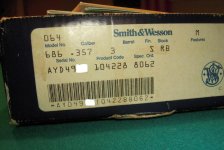This is not meant to be a definitive thread on the US Customs Service 686 CS-1 revolvers. This thread is a distillation of information I have gathered on this, and other boards. As well as from folks who were there and know about these fine revolvers.
A great deal of the information in this thread was provided by SmithNut, in threads on this very board. I cannot locate these threads, many from 2003 to 2006. Sadly, one of the last exchanges I had with SmithNut was when I posted that the older CS-1 threads were "pruned". SmithNut declared that to be "misinformation". In any case, I cannot locate them. If anyone can, please provide links to them in this thread.
If you have additional or conflicting information, by all means please post it here. If you were a Customs Service officer or employee please join in the conversation and relate what you know.
The information I am posting is from hundreds of pages of 686 CS-1 threads I printed at the time, and filed over the years. It is only from the public posts. Not PM's or Emails.
Thank you SmithNut for all of your expertise that you so willingly shared with us and your patience in answering our endless and sometimes repetitive questions about the CS-1 revolvers.
Lets start by defining what a 686 CS-1 is.....and is not. The 686 CS-1's were NOT Performance Center guns. The Performance Center had not been created yet when the CS-1's were produced. The 686 CS-1's were factory guns made to the US Customs Service specifications.
Made in 1988 according to the SCSW, 1987 to 1992 according to various other sources, the 686 CS-1's were 6-shot 686's made in three barrel lengths, 3 inch - 4 inch and a small quantity (unknown how many) of 6 inch guns for the Customs Service pistol team.
The 686 CS-1's were finished in a dull gray bead blast finish with flash chromed hammers and triggers. They featured a narrow black blade front sight (1/10) and plain black rear sight. The firing pin was mounted on the hammer. All three barrel lengths featured a round butt grip frame. All the 686 CS-1's delivered to the Customs Service were shipped with Pachmayr RB Compact grips. More on the grips in later posts.
A great deal of the information in this thread was provided by SmithNut, in threads on this very board. I cannot locate these threads, many from 2003 to 2006. Sadly, one of the last exchanges I had with SmithNut was when I posted that the older CS-1 threads were "pruned". SmithNut declared that to be "misinformation". In any case, I cannot locate them. If anyone can, please provide links to them in this thread.
If you have additional or conflicting information, by all means please post it here. If you were a Customs Service officer or employee please join in the conversation and relate what you know.
The information I am posting is from hundreds of pages of 686 CS-1 threads I printed at the time, and filed over the years. It is only from the public posts. Not PM's or Emails.
Thank you SmithNut for all of your expertise that you so willingly shared with us and your patience in answering our endless and sometimes repetitive questions about the CS-1 revolvers.
Lets start by defining what a 686 CS-1 is.....and is not. The 686 CS-1's were NOT Performance Center guns. The Performance Center had not been created yet when the CS-1's were produced. The 686 CS-1's were factory guns made to the US Customs Service specifications.
Made in 1988 according to the SCSW, 1987 to 1992 according to various other sources, the 686 CS-1's were 6-shot 686's made in three barrel lengths, 3 inch - 4 inch and a small quantity (unknown how many) of 6 inch guns for the Customs Service pistol team.
The 686 CS-1's were finished in a dull gray bead blast finish with flash chromed hammers and triggers. They featured a narrow black blade front sight (1/10) and plain black rear sight. The firing pin was mounted on the hammer. All three barrel lengths featured a round butt grip frame. All the 686 CS-1's delivered to the Customs Service were shipped with Pachmayr RB Compact grips. More on the grips in later posts.
Last edited:


